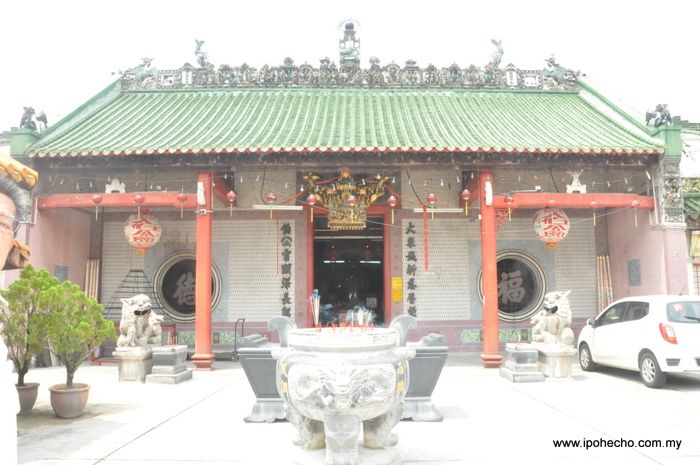A Hidden Gem: Paloh Khoo Miu Temple


Cover Story
By Tan Mei Kuan
Many have set foot in the ever popular cave temples of Ipoh such as the Sam Poh Tong Temple, Ling Sen Tong Temple and Perak Tong Temple. One hidden gem that Ipoh Echo has discovered is the Paloh Khoo Miu Temple, a burst of rainbow colours that leap out right behind People’s Park. It may be relatively smaller in size but its rich history and distinctive style are not any less spectacular than other temples.


A Deviation from the Usual Tourist Trail
144 Years and Counting
Paloh Khoo Miu Temple was built in 1872 by prominent tin miner cum philanthropist, Leong Fee and was gazetted as a place of worship in 1894 by the British Colonial Government. Thus, it is one of the oldest Chinese temples in Perak.
Its name is derived from what Ipoh was fondly known as back then, “Paloh”. The main feature of the single-storey holy place is dedicated to Tai Pak Koong, the God of Blessing and Ethics. Hence, it was also referred to as the “Ipoh Chinese Tai Pak Koong Temple” by the locals.
Born in the Mei Xian district in Guangdong Province of China, Leong Fee came to Ipoh by river from Penang. He brought with him the spirit of the deity with burning joss sticks from a temple in Hai Zhu Island near Penang and founded the temple alongside the Kinta River to give thanks for safe arrival. In 1894, Leong Fee and Yau Tet Shin, another famous miner, entrepreneur and pioneer of Ipoh, successfully applied to the British Colonial Government for a piece of land to build the temple at its present site.


Initially, the sacred site provided free medical consultations and medicines to locals suffering from illnesses. It was also a place of justice for the residents to resolve their disputes and differences.
When the Japanese Imperial Army invaded in 1941, all activities of the ancient temple came to a stop while all its precious records, documents and photographs were destroyed by fire causing part of its history to be lost forever. After the Japanese Occupation, Lau Pak Kuan, later to become the first Chinese Dato’ Seri, was elected as the chairman of the board of governors in charge of reviving the temple and laying the foundation of its size today.
In a bid to boost local Chinese education, the temple donated its adjacent vacant land to establish a three-storey Perak Chinese Girls Primary School in 1951. Lau also initiated a temple school in 1954, where the poor and pupils who were already beyond school age received free education, books and stationery. It could accommodate up to 400 students at a time during its heyday and had produced more than 1400 graduates until its closure in 1994. This was one of its biggest contributions to the community.


Upon the closure of the free school, the balance of the temple’s revenues were donated to various schools and welfare organisations in Ipoh. Its charitable efforts continue to this day with annual donations.
Two renovations were carried out in 1967 and 1994 respectively to preserve its glorious heritage. Under the leadership of president Ho Fah See, a conference room and a hall displaying relics were set up. Since then, all walls within the place of worship were decorated with tiles for a brighter look.
Artefacts of Beauty and Grace
Driving through a decorated archway, visitors can park in the designated lots in the temple grounds. One will be greeted by a pair of auspicious stone sentry lions guarding its main entrance. Upon entering, its sunlit main hall is flanked by the eight bronze ceremonial weaponry. I especially adore how its retractable roof opens up to a miniature square of heaven above, while visitors bask in the long history of the holy place below.


During my first visit here, I had an exclusive one-on-one with the current temple committee made up of chairman, Yeong Chin Chun; vice chairman, Dato’ Hew Choy Kon; secretary, Phan Toong Sean; and member of the advisory panel, Hansen Lau, a son of Lau Pak Kuan. They enlightened me on the well-kept artefacts and intricate architectural detailing that adorns the temple.


Of particular interest is the mythological sea turtle. A symbol of wisdom, its resplendent shades of turquoise and blue bring vitality to the textured sculpture. The curvaceous sea turtle is also decorated with wonderfully scaled skin, undulating fins and long whiskers which left me in awe.
“The ornamental carving of exquisite craftsmanship that stretches across the roof ridge actually tells a story. Sadly, it is unable to be traced yet. It contains moral teachings like doing good deeds,” Dato’ Hew disclosed to Ipoh Echo.


Equally impressive are the century-old joss stick holders at the altar and medicinal formulae all the way from Foshan, Guangdong. Hence, one of the highlights is a collection of ten carved wooden and metal blocks for stamping of medicinal formulae. Each block is inscribed with five different formulas for printing.
At the altar of Tai Pak Koong is an intricate wooden carving covered with antique gold leaf, a standing testament of how devotees have put their hearts and souls to honour the deity.
Meanwhile, its yard houses a dragon squirting water from his wishing pond flanked by two carp-filled ponds, adding to the serenity. The ringing of the 123-year-old copper centennial bell and drum each time an offering is made together with the bubbling water create a soothing tone that encourages introspection.


The Worshippers with Devout Homage
Paloh Khoo Miu Temple receives the most number of visitors during Chinese New Year Eve and the birthday of Tai Pak Koong, which falls on February 16 of the lunar calendar. The latter is an annual grand affair which lasts for days and nights to thank the deity for his blessings. However, this place of worship is stunning even outside of celebration periods. During my visit on a weekday, there was an intermittent stream of believers weaving through the pillared hall laced with exquisite figures.
“I left Tangshan when I was just five years old. When I was younger, my mother would bring me here for prayers. Now, my voluntary work here gives me comfort. I hope there will be more devotees,” 85-year-old Phan Toong Sean shared.
“I usually come with my friend, since the beginning of last year. We usually pray for general wellbeing. I heard that this temple will make your prayers come true! Of course, we must also think good, speak good and do good,” a retiree from Bercham, who wished to remain anonymous, said.
“I first knew about the temple when I played by the riverside during my childhood. I think it is well-preserved, as it has not changed much throughout the years,” a retired businessman who was there for the first time told Ipoh Echo.
Other regulars here include Dato’ Dr Mah Hang Soon, the Executive Councillor for Health, Public Transport, Non-Islamic Affairs, National Integration and New Villages. According to the committee, there is an increasing number of worshippers from all walks of life every year.
Conclusion
Paloh Khoo Miu Temple provides a more relaxed visit than the more popular cave temples in Ipoh. This religious sanctuary is where you really can experience the sense of serenity it is designed to inspire.
If you know of any other lesser known temples that should be in a travel list, write in to us! Ipoh Echo will also feature Hindu temples, mosques, churches and gurdwaras throughout the year.
Address: 89-91, Jalan Bijih Timah, 30000 Ipoh Contact: +605 255 0407 GPS Coordinates: N 04° 35.609’ E 101° 4.736’ Opening hours: 7am to 4pm daily

